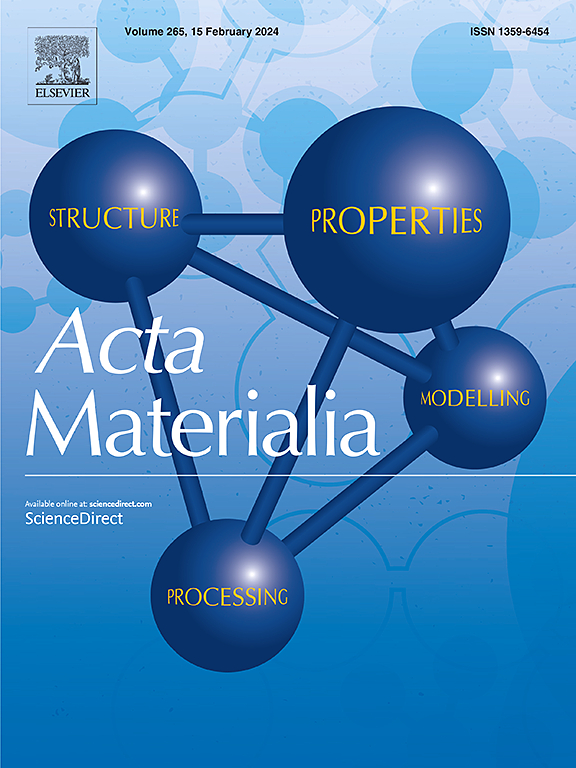增材制316L钢在铅铋共晶液中的原子溶解腐蚀机理
IF 8.3
1区 材料科学
Q1 MATERIALS SCIENCE, MULTIDISCIPLINARY
引用次数: 0
摘要
本文研究了激光粉末床熔合(LPBF)制备的316L钢在反应器相关氧浓度为~ 5×10−7wt的条件下,在多长度尺度下暴露于静态铅铋共晶(LBE)中,有和没有后续热等静压(HIP)的溶解腐蚀机制。%溶解,在500℃下长达4000h。结果表明,两种钢均发生溶解腐蚀,LBE优先攻击缺陷区。“LPBF 316L”钢的平均溶解深度远大于“LPBF+HIP 316L”钢,说明LPBF产生的非平衡缺陷显著加剧了溶解腐蚀,而经过HIP处理后,耐溶性恢复。溶解区总是发生奥氏体到铁素体的相变。Kurdjumov-Sachs (K-S)和Nishiyama-Wassermann (N-W)是α和γ相的主要取向关系(ORs),特别是在“LPBF+HIP 316L”钢中。虽然也发现了Pitsch OR,但它只占一小部分。原子分辨率表征表明,在沿机械纳米孪晶边界的渗透尖端,在钢基体和纳米尺寸的非晶态氧化物之间的界面上形成了一个1纳米厚、富含Bi和Ni的相干界面相,促进了Ni的浸出。理论计算证实,铋在奥氏体钢表面的偏析在能量上比Pb更有利。由于Ni-Bi体系的混合焓为负,Bi的界面偏析有利于Ni的向外扩散。铁和铬也通过氧化/分解过程提取。因此,溶解过程包括同时去除所有三种钢元素,而不仅仅是Ni。提出了一种原子尺度的溶解机理方案。本文章由计算机程序翻译,如有差异,请以英文原文为准。


Atomic-scale dissolution corrosion mechanism of additively-manufactured 316L steels in liquid lead-bismuth eutectic
In this paper, the dissolution corrosion mechanism of 316L steels fabricated by laser-powder-bed-fusion (LPBF) with and without subsequent hot-isostatic-pressing (HIP) has been studied under multilength scales after exposure to static lead-bismuth eutectic (LBE) with a reactor-relevant oxygen concentration of ∼5 × 10−7 wt.% dissolved, at 500 °C for up to 4000h. The results show that both steels are subjected to dissolution corrosion with LBE preferentially attacking defective areas. The average dissolution depths of “LPBF 316L” steel are much larger than those of “LPBF+HIP 316L” steel, suggesting that the nonequilibrium defects generated by LPBF significantly exacerbate dissolution corrosion, whereas dissolution resistance recovers following HIP treatment. The dissolution zones invariably undergo austenite-to-ferrite phase transformation. Kurdjumov-Sachs (K-S) and Nishiyama-Wassermann (N-W) are the predominant orientation relationships (ORs) of α and γ phases, especially in “LPBF+HIP 316L” steel. While Pitsch OR is also identified, it constitutes only a small fraction. Atomic-resolution characterization reveals that at the penetration tips along mechanical nanotwin boundaries, a one-nanometer-thick, Bi- and Ni-rich, coherent interfacial phase forms at the interface between steel matrix and a nanosized amorphous oxide scale, mediating the leaching of Ni. Theoretical computations confirm that Bi is energetically more favorable than Pb in segregating on austenitic steel surfaces. The interfacial segregation of Bi facilitates the outer diffusion of Ni due to the negative enthalpy of mixing of the Ni-Bi system. Fe and Cr are also extracted through oxidation/decomposition processes. Consequently, the dissolution process involves simultaneous removal of all three steel elements, rather than just Ni. An atomic-scale dissolution mechanism scheme is proposed.
求助全文
通过发布文献求助,成功后即可免费获取论文全文。
去求助
来源期刊

Acta Materialia
工程技术-材料科学:综合
CiteScore
16.10
自引率
8.50%
发文量
801
审稿时长
53 days
期刊介绍:
Acta Materialia serves as a platform for publishing full-length, original papers and commissioned overviews that contribute to a profound understanding of the correlation between the processing, structure, and properties of inorganic materials. The journal seeks papers with high impact potential or those that significantly propel the field forward. The scope includes the atomic and molecular arrangements, chemical and electronic structures, and microstructure of materials, focusing on their mechanical or functional behavior across all length scales, including nanostructures.
 求助内容:
求助内容: 应助结果提醒方式:
应助结果提醒方式:


